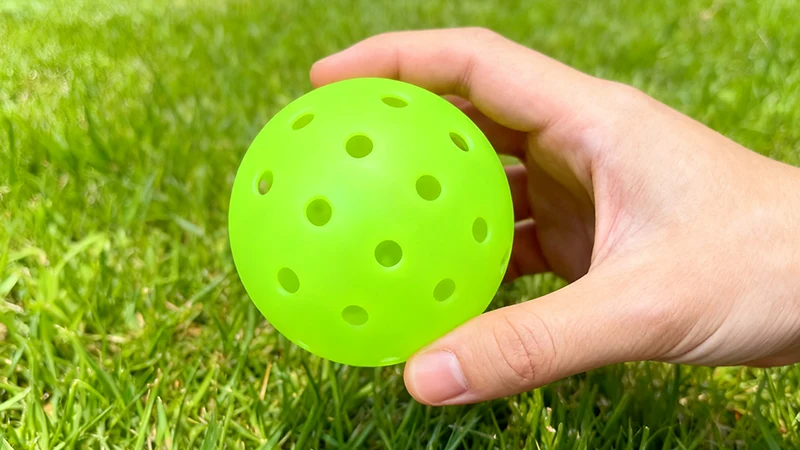What Makes a 48 Holes Pickleball Ball Different?

CEO & Technical Expert at Pickleball Equipment Company (Art Pickleball)
Specialize in manufacturing pickleball paddles, pickleball balls, and pickleball accessories.

- What Is a 48 Holes Pickleball Ball
- The Science Behind the 48 Holes
- Flight Performance: Straighter, Smoother, More Predictable
- Material & Durability: Built to Last
- Bounce & Spin Control: Feel the Difference
- Designed for Outdoor Play — But Versatile Enough for Both
- Why More Holes Don’t Mean Less Strength
- Who Should Use a 48 Holes Pickleball Ball
- 40 vs. 48 Holes: Quick Comparison
- Choosing the Right 48 Holes Pickleball Balls for You
- FAQs About 48-Hole Pickleball Balls
- Final Thoughts
If you’ve ever picked up two pickleball balls and noticed they feel a bit different — even if they look the same size — you’re not imagining things.
One of the biggest factors behind that difference is how many holes the ball has.
Most balls have 26, 40, or 48 holes, and that last number — 48 — has become a new trend among professional and outdoor players.
So, what exactly makes a 48-hole pickleball ball stand out?
Let’s break it down together.
What Is a 48 Holes Pickleball Ball
A 48 holes pickleball ball is designed with 48 precision-drilled holes, evenly spaced to balance airflow, bounce, and spin.
Compared to the standard 40 holes outdoor ball, it delivers tighter control, smoother flight, and more consistent performance — especially in windy or humid conditions.
The Science Behind the 48 Holes
Every hole in a pickleball ball affects airflow and stability.
When the ball moves through the air, each hole creates drag — and the more balanced that drag is, the smoother the flight.
A 48 holes design means:
- Smaller holes = reduced air resistance
- Even distribution = less wobble and better directional control
- Higher spin potential = easier to place accurate shots
Think of it like this:
- A 40 holes ball is like a sports car — fast but sensitive to bumps (wind).
- A 48 holes ball is like a luxury car — smooth, controlled, and stable even at high speeds.
Flight Performance: Straighter, Smoother, More Predictable
Wind is every outdoor player’s enemy.
A ball with fewer or larger holes tends to wobble mid-air or get pushed off course.
That’s why many competitive players are switching to 48 holes designs.
They cut through the air more evenly, resulting in:
- Less wind interference
- Better shot placement
- A straighter flight path
It’s particularly noticeable on serve returns and dinks, where control matters more than power.
Material & Durability: Built to Last
Most 48 holes balls are made from high-quality polymer blends, such as seamless rotationally-molded polyethylene.
This ensures:
- Uniform wall thickness
- Longer life span
- Consistent bounce
Because the holes are smaller and evenly spaced, the stress on the material is more evenly distributed — reducing cracks and deformation after long rallies or in cold temperatures.
Bounce & Spin Control: Feel the Difference
Players often describe 48 holes balls as having a “controlled pop.”
That means they don’t jump too high or bounce unpredictably.
Here’s how it feels in play:
- Spin shots: Easier to grip the paddle’s surface
- Dinks: More consistent and predictable
- Serves: Less wobble, more aim precision
If you’re transitioning from indoor to outdoor play, the 48 holes ball gives you that balanced in-between feel — not too fast, not too slow.
Designed for Outdoor Play — But Versatile Enough for Both
Although 48 holse balls are primarily built for outdoor games, many players also use them indoors because of their hybrid performance.
| Environment | Performance |
|---|---|
| Outdoor courts | Excellent wind resistance & flight control |
| Indoor courts | Slightly firmer bounce but still playable |
| Humid weather | Maintains stability & shape |
So if you only want one type of ball that can handle both environments well — the 48 holes design is your go-to.
Why More Holes Don’t Mean Less Strength
A common myth is that more holes make a ball weaker.
That’s not true with modern manufacturing.
In fact, top manufacturers use precision-molded designs that reinforce the structure.
Each hole’s edge is micro-smoothed to prevent cracking and ensure a balanced compression response.
In other words — more holes = better aerodynamics, not fragility.
Who Should Use a 48 Holes Pickleball Ball
You’ll love a 48 holes ball if you:
- Play outdoors and hate how wind ruins your shots
- Prefer smooth, predictable flight
- Like control over raw speed
- Compete in advanced-level matches or club games
Casual players will also notice it’s just more fun to rally with — every shot feels more “clean” and accurate.
40 vs. 48 Holes: Quick Comparison
| Feature | 40 Holes Pickleball Ball | 48 Holes Pickleball Ball |
|---|---|---|
| Hole Size (Diameter) | 7mm | 6mm |
| Airflow | Moderate drag | Smoother, more balanced |
| Wind stability | Good | Excellent |
| Speed | Slightly faster | Slightly slower but steadier |
| Control | Moderate | High |
| Durability | High | Very High |
If you’re serious about refining your game — the 48 holes upgrade is worth it.
Choosing the Right 48 Holes Pickleball Balls for You
When shopping for pickleball balls, don’t just look at the number of holes — pay attention to:
- Material quality
- Weight and bounce consistency
- USAPA approval
- Durability in cold or hot conditions
At Art Pickleball, we offer pro 48 holes pickleball balls built for both professional and recreational play — combining consistent flight, solid durability, and OEM-ready customization.
FAQs About 48-Hole Pickleball Balls
Q1. Are 48 holes balls tournament-approved?
Some brands are USAPA-approved, but always check the packaging or certification details.
Q2. Can I use them indoors
Yes! While designed for outdoor use, many players enjoy the controlled bounce indoors too.
Q3. Do 48 holes balls last longer than 40 holes ones?
Generally yes — the smaller, evenly spaced holes distribute impact stress more evenly.
Q4. Are they heavier?
Not really. The difference is minimal — but the weight distribution makes them feel more stable.
Final Thoughts
So, what makes a 48-hole pickleball ball different?
It’s all about balance — between speed, control, and durability.
If 40 holes balls are made for power, 48 holes balls are made for precision.
And in a game where every rally counts, that difference could be what takes your play to the next level.
